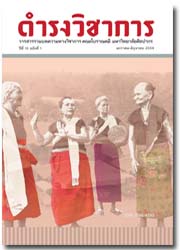Understanding Politeness Strategies: A Study of Tourist Police Service Encounters Through Discourse Approach
Keywords:
Thai Tourist Police, politeness, intercultural communication, discourse studies, interdiscourse communicationAbstract
This paper is a study to investigate politeness strategies and the politeness system of 10 Thai tourist police officers in service encounters with foreign tourists at two Tourist Report Centers in Thailand. A study is conducted to answer two research questions: 1) What are the politeness/face strategies of Thai tourist police when they communicate with tourists at the Thai Tourist Center? 2) What is the politeness/face system utilized in the interactions between tourists and tourist police at the Thai Tourist Report Center? Discourse approach following Scollon, Scollon, and H. Jones (2012) is applied to study the encounters at both lexical and discursive levels. The study has found that the tourist police employed speech acts of directives and assertives the most frequently in the encounters. For face/politeness strategies, the participants employed a mix of bald-on-record, involvement politeness, and independence politeness strategies. Last but not least, the hierarchical face/politeness system is prevalent in the encounters as tourists are empowered by factors in the context including roles, responsibilities, physical setting, and physical appearance.
References
Austin J.L., 1962. How to Do Things with Words. Oxford: Oxford University Press.
Bou-Franch P. & Garces-Conejos P., 2003. “Teaching Linguistic Politeness: A Methodological Proposal.” IRAL 41 (1): 1-22.
Brown P. & Levinson S.C., 1978. Politeness: Some Universals in Language Usage. Cambridge: Cambridge University Press.
Cargill M., 1998. “Cross-cultural Postgraduate Supervision Meetings as Intercultural Communication.” In M. Kiley & G. Mullins (eds.), Paper presented at the Quality in Postgraduate Research: Managing the New Agenda (pp. 175-187). Adelaide: The University of Adelaide, 23-24 April 1998.
Department of Tourism, 2015. Overview of Tourists in Thailand. Tourism and Sports Ministry.
Drew P. & Heritage J., 1992. Talk at Work: Interaction in Institutional Settings. Cambridge: Cambridge University Press.
Fasold R., 1990. Sociolinguistics of Language. Cambridge: Basil Blackwell.
Grice H.P., 1975. “Logic and Conversation.” In P. Cole & J.L. Morgan (eds.), Syntax and Semantics, Vol. 3: Speech Acts (pp. 41-58). New York : Academic Press.
Gu Y., 1990. “Politeness Phenomena in Modern Chinese.” Journal of Pragmatics 14 (22): 237-257.
Ide S., 1982. “Japanese Sociolinguistics: Politeness in Women’s Language.” Lingua 57: 357-387.
Mao L.R., 1994. “Beyond Politeness Theory: ‘Face’ Revisited and Renewed.” Journal of Pragmatics 21 (5): 451-486.
Matsumoto Y., 1988. “Reexamination of the Universality of Face: Politeness Phenomena in Japanese.” Journal of Pragmatics 12 (4): 403-426.
Merritt M., 1976. “On Questions Following Questions in Service Encounters.” Language in Society 5: 315-357.
Pan Y., 2000. Politeness in Chinese Face-to-face Interaction. Vol. 67. U.S.A.: Ablex.
Reiter R.M. & Placencia M.E., 2004. Displaying Closeness and Respectful Distance in Montevidean and Quiteño Service Encounters. Amsterdam: John Benjamins.
Schiffrin D., 1987. Discourse Markers. Cambridge: Cambridge University Press.
Scollon R. & Scollon S.W., 1995. Intercultural Communication : A Discourse Approach. Oxford: Blackwell.
Scollon R., Scollon S.W. & Jones R.H., 2012. Intercultural Communication: A Discourse Approach. 3rd ed. Oxford: Wiley-Blackwell.
Searle J.R., 1969. Speech Acts: An essay in the philosophy of language. Cambridge: Cambridge University Press.
Searle J.R., 1979. Expression and Meaning: Studies in the Theory of Speech Acts. Cambridge: Cambridge University Press.
Sodpiban P., 2002. Intercultural Communication in Tourism Development. Language Institute, Prince of Songkla University, Phuket campus.
Tannen D., 1984. Conversational Style: Analysing Talk Among Friends. Norwood: Ablex.
Tannen D., 1989. Talking Voices: Repetition, Dialogue and Imagery in Conversational Discourse. Cambridge: Cambridge University Press.
Tannen D., 1990. You Just Don’t Understand: Women and Men in Conversation. New York: William Morrow.
Tannen D., 1996. That’s Not What I Meant!: How Conversational Style Makes or Breaks Your Relations with Others. New York: Ballantine.
Ting-Toomey S., 1988. “Intercultural Conflict Styles: A Face-Negotiation Theory.” In Y.Y. Kim & W.B. Gudykunst (eds.), Theories in Intercultural Communication. CA: Sage.
Tipmontree S., 2007. The Use and the Problems of English and Intercultural Communication Skills of Thai Tourist Police Officers. Master’s dissertation, University of Thai Chamber of Commerce, Bangkok.
Downloads
Published
Issue
Section
License
บทความนี้เป็นผลงานของข้าพเจ้าแต่เพียงผู้เดียว และ/หรือเป็นผลงานของข้าพเจ้าและผู้ร่วมงาน ตามชื่อที่ระบุในบทความจริง และเป็นผลงานที่มิได้ถูกนำเสนอหรือตีพิมพ์ที่ใดมาก่อน





